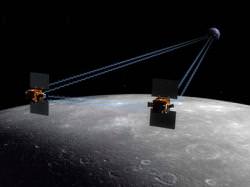The Moon is a pretty popular destination these days: Google’s X-Prize is already getting applicants, Kaguya and Chang’e-1 are currently snapping pictures and taking measurements, and both India and the U.S. have missions lined up to launch in the next 10 years or so. MIT announced last week that it would join in on the fun, designing a spacecraft to study the Moon, schedule for launch in 2011.
In cooperation with NASA, MIT head a up a mission to send two satellites to simultaneously study the gravity field of the Moon in detail. Named GRAIL (Gravity Recovery and Interior Laboratory), the mission will study the gravity of the Moon to shed light on its thermal history and composition. By using two satellites to do so, GRAIL will create a map of the Moon’s gravity field that is 1,000 times more accurate than previous maps.
“After the three-month mission is completed, we will know the lunar gravitational field better than we know Earth’s,” said Maria Zuber, head of MIT’s Department of Earth, Atmospheric and Planetary Sciences, who will lead the mission.
GRAIL will use a similar method employed by GRACE (Gravity Recovery and Climate Experiment), a mission that has been mapping Earth’s gravitational field since 2002: two satellites constantly measure the distance between each other with great accuracy, thus creating a map as they orbit the Earth and travel through its gravity field.
GRACE uses GPS technology for the positioning of the satellites, something impossible to do on the Moon. Instead, the GRAIL satellites will precisely monitor radio signals coming from the Earth. This technology could also be used in future missions to other planets such as Mars and Venus.
Knowing the interior composition and history of the Moon will allow scientists to have a better understanding of the history of other planets in our Solar System. The evolution of the Moon, and the history of its many impact craters will help to create models for its formation, which serves as a record of planetary formation in the inner planets. Any future missions to land on the Moon could also benefit from extended mapping of the gravity field, as landers could use this data to prevent crashes and help navigate to the surface.
The mission will cost an estimated $375 million. The satellites will be constructed by Lockheed Martin Space Systems in Denver, Colo. and NASA’s Jet Propulsion Laboratory will develop the communication and navigation systems.
Original Source: MIT Press Release

